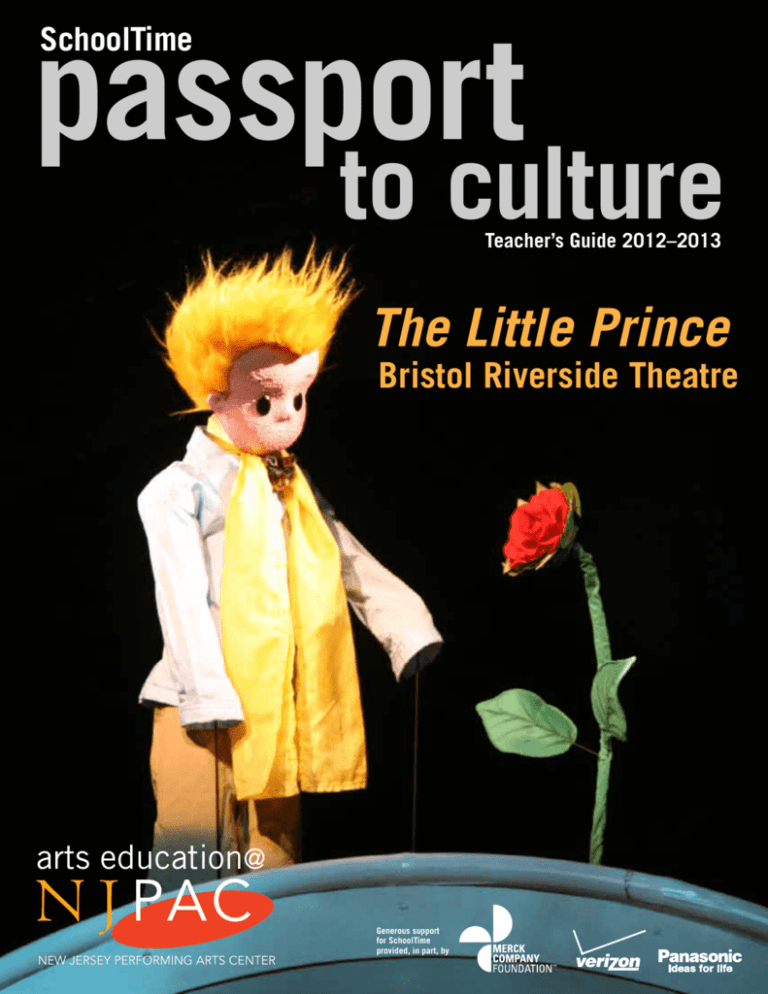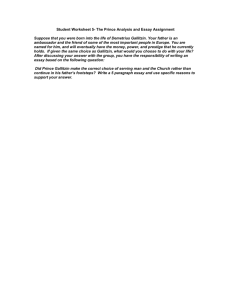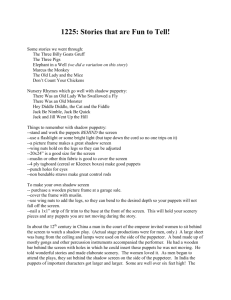
passport
SchoolTime
to culture
Teacher’s Guide 2012–2013
The Little Prince
Bristol Riverside Theatre
arts education@
NEW JERSEY PERFORMING ARTS CENTER
Generous support
for SchoolTime
provided, in part, by
njpac.org • The Little Prince 1
arts education@
NEW JERSEY PERFORMING ARTS CENTER
contents
On Stage 3
A timeless tale from France
Meet the Artists 4
“Translating” Prince for theater
Did You Know? 5
Puppetry across the globe
In the Classroom 6
Related activities and resources
Kid Power!
Through energy efficiency and
conservation, kids can help preserve
our planet’s rich natural resources and
promote a healthy environment.
TIP OF THE DAY
Royal guard
Since 1942, the Little Prince has tended his
planet, despite its harsh conditions. Litter is
a problem right here on Earth. Protect the
ecosystem by picking up trash when you
see it, or perhaps recycle it. Recycling a
single can of soda saves enough energy
to keep a bulb lit for half a day.
Made possible through the generosity
of the PSEG Foundation.
Students in Dancing ClassroomsTM New Jersey, an NJPAC In-School Residency Program
The New Jersey Performing Arts Center (NJPAC) Arts Education Department presents
the 16th season of the Passport to Culture SchoolTime Performance Series.
Teacher’s Resource Guide
This guide will help you prepare your class for an enriching experience at our
SchoolTime Passport to Culture Performance. We provide discussion ideas, activities
and reading resources that promote arts literacy in your classroom and link to New
Jersey’s Core Curriculum Content Standards. You can find additional resources online
at artsed.njpac.org.
Permission is granted to copy and distribute this guide to any class attending a
2012–2013 SchoolTime performance (all other rights reserved).
NJPAC Arts Education
At NJPAC, our mission is to join with parents, teachers and community to cultivate
an appreciation of the arts for all children in all schools. We believe the arts provide
an effective means of knowing and learning that helps children find the self-esteem,
poise and confidence they need to succeed in every facet of life. Our innovative
programs are designed to engage the artist in every child.
In-School Residencies
NJPAC brings the joy of dance, music and theater directly into your classroom
with In-School Residencies. Our teaching artists create stimulating performing
arts experiences that engage students’ imaginations and encourage self-expression.
Residencies are customized to meet the curricular goals of the classroom teacher.
Each residency ends with a performance that teaches students to work together and
believe in themselves.
SchoolTime and Family Performances
Open a world of culture to your students through performances of music, dance,
storytelling, theater, and puppetry through professional stage productions by local,
national and international artists. Performances are enriched by teacher resource
guides as well as Q&A sessions with the artists.
Arts Training Programs
Students interested in acting, dance, musical theater, vocal or instrumental music will
find an artistic home at NJPAC where creative expression and solid technique serve as
cornerstones of the Arts Training programs. Teaching Artists with exceptional professional experience guide students at all levels of arts learning (beginner, intermediate
and advanced) to greater creative understanding and self-confidence.
visit artsed.njpac.org
Find additional resources by clicking on SchoolTime Performances
2 The Little Prince • njpac.org
on stage
‘Prince’ charming
The title character of The Little Prince marvels that his Rose is unlike all others.
By Michael Redmond
It’s a modest little tale that has been
translated into more than 250 languages
and voted the best book of the 20th century
in France. More than 200 million copies
have been sold worldwide. The Little Prince
(Le Petit Prince, 1943), by Antoine de
Saint-Exupéry, has been adapted for radio,
television, the stage, musical theater, opera,
ballet, even a symphony.
Now this timeless classic is a puppet
show, thanks to Bristol Riverside Theatre,
based in Bristol, Pennsylvania.
Writer, poet, illustrator, trail-blazing
aviator and war hero, Saint-Exupéry, who
was born June 29, 1900, in Lyon, France,
packed a lot of life into only 44 years. In
1935 he crash-landed in the Sahara Desert
trying to break the speed record for ParisVietnam air travel, and was rescued, near
death, four days later. In The Little Prince,
the story opens following a pilot’s crash in
the Sahara, where he encounters the title
character.
Saint-Exupéry wrote and illustrated The
Little Prince in 1942 in New York City
and Asharocken, Long Island. He was in
exile from France, which had fallen to Nazi
Germany; he came to the United States,
where he was already a well-known author,
to advocate for quick action to liberate his
country.
On July 31, 1944, Saint-Exupéry died
when his plane went missing during a
The Little Prince is a fable for adults,
disguised as a children’s story. As such, it
speaks to everybody’s experience of life and
human nature. It sends many messages, but
perhaps the most famous comes from the
Fox, who tells the Little Prince, “This is my
secret. It’s very simple. It’s only with the
heart that one can see clearly. What’s most
important is invisible to the eyes.”
“Grown-ups never understand anything by themselves,
and it is tiresome for children to be always and forever
explaining things to them.”
— Antoine de Saint-Exupéry
photo-reconnaissance mission for the Allies.
Thought too old for active service, he had
relentlessly campaigned for permission to
join the war effort. The wreckage of his
plane was discovered in May 2000, south of
Marseille, France, in the Mediterranean Sea.
Michael Redmond has written for The
Star-Ledger, The Princeton Packet and
numerous other publications. He is a
winner of the Distinguished Service to the
Arts Award from the New Jersey State
Council on the Arts.
njpac.org • The Little Prince 3
MEET THE ARTISTS
The version of The Little Prince that
Bristol Riverside Theatre (BRT) adapted for
puppets originated some 30 years ago with
a musical theater treatment, which features
a score by Rick Cummins and a script
by the late John Scoullar. The CumminsScoullar version basically streamlines and
tightens Antoine de Saint-Exupéry’s story by
eliminating some characters and changing
the order of events. The musical received its
world premiere at the Cherry Lane Theatre
in New York City.
“Following the premiere, many people
wanted to do it as a play, not a musical, so
Rick (Cummins) and John (Scoullar) were
happy to go along with that,” says Amy
Kaissar, BRT’s managing director. “They
were both in love with the story. They’ve
adapted it many times.”
Three years ago, BRT decided to create
a puppet version of The Little Prince, “and
Rick and John just lit up,” says Kaissar.
“They said they had always imagined it
done with puppets, and they set about
adapting the show again,” working
with a staging by puppeteer Scott Hitz.
BRT’s production is directed by Susan D.
Atkinson.
About 60 minutes long, The Little Prince
calls for four actor-puppeteers who play
a range of characters, including the Little
Prince, the Rose, the Desert Flower, and
the Fox, and an actor who doubles as the
Aviator and the Snake. The puppeteers need
to be proficient in a range of puppetry techniques, including bunraku, shadow, hand,
and rod.
The puppets were created by awardwinning designer Michael Schupbach of Jim
Henson’s Muppet Workshops, and puppet
builders Monkey Boys Productions, whose
Broadway work includes Avenue Q and
Little Shop of Horrors.
“Our directions were clear,” Schupbach
says. “We very much wanted the puppets to
look familiar to those who know the book,
so they would feel like you were seeing a
fair and accurate representation. We wanted
to treat the book reverently, but put our
own stamp on the characters. The writers
helped us to stay true.”
From page
to stage
Award-winning puppeteer Michael Schupbach shares the stage with characters from The Little Prince.
BRT’s production uses a recorded sound
design by Cummins (there are no songs);
a set consisting of two circles (one on the
floor, the other behind a video screen); and
special lighting effects.
“So many things happen in the book that
you just can’t do,” Kaissar says. But puppets
offer their own special advantages. “When
“(The book’s) heart is about love, how to see
the world, how to do what’s right.”
— Amy Kaissar
4 The Little Prince • njpac.org
the Rose comes onstage, she’s a rose; when
she blooms, she actually blooms. When
people play these roles, it limits what you
can do. It makes sense to do these roles
with puppets.”
When BRT introduced its production,
The Little Prince played for cross-generational audiences on the theater’s main stage.
“I always thought of this story as a kid’s
thing. But what an incredibly meaningful
book this is,” Kaissar says. “Its heart is
about love, how to see the world, how to
do what’s right. The adults who have seen it
love it, too.”
— M.J.
The global art of
puppetry
By Patricia Petrey Dees
Puppetry, an ancient art form, incorporates the visual, theatrical, musical, and
literary arts into one holistic structure. It is
a marriage of sculpture and painting with
choreography, mime, acting, and language
that demands multidisciplinary excellence
from its creators.
Nearly every culture in the world has a
puppetry tradition in its present or past.
With its roots in ritual, puppetry allowed
ancient civilizations to revere their gods,
celebrate their heroes and transport spirits.
As puppetry spread around the world,
its applications varied and flourished
according to the needs of society. Weddings,
funerals, births, folklore, political satire,
and entertainment have all used puppetry
as an exploratory medium. Five main styles
developed over the centuries: shadow, hand,
string/marionette, rod, and body. Here are
highlights of these styles.
Shadow puppets
In India and Southeast Asia, shadow
puppetry is considered the oldest form of
puppetry and is believed to date to prehistoric times. It has its roots in shamanistic
rituals and funerary rites. In Indonesia,
puppetry is woven into culture as a means
of education, entertainment and ritual.
Shadow puppet plays, or wayang purwa,
play a significant role in festivals, rites
of passage and religious observances.
The plays provide entertainment while
instructing audiences in morality, social
interactions and values.
In a shadow performance, the puppeteer, known as the dalang, sits behind a
translucent fabric screen and uses rods
to manipulate flat leather figures, known
as wayang kulit. The screen is lit by an
oil lamp or firelight. Often 100 to 500
puppets are used in a single performance. A
gamelan orchestra accompanies the dalang.
The performance may last from sunset to
sunrise.
DID YOU KNOW?
A close-up shows how a puppeteer brings the Fox to life in The Little Prince.
warriors, historical battles and stories of
love or ghosts are all common themes of
Chinese puppet theater.
Punch and Judy, associated with
Victorian England and used to satirize
society, had its beginnings in France
and Italy. In Germany, Punch is called
Kasper and Judy is Grete; in Italy Punch
is Pulcinello (with Pulcinella as the female
part); and in France, Punch is known as Le
guignol.
Marionettes (string puppets)
In 5th century BCE, the Greek historian
Herodotus wrote of string puppets used
in the Festival of Osiris in Egypt. Chinese
string puppets are manipulated from above
with a minimum of eight strings, but may
have up to 40 strings controlled by two
people. The term marionette originated
from the use of string puppets to enact the
Nativity over 500 years ago in France. The
figures were referred to as “Little Marys” or
marionettes.
Hand/glove puppets
Rod puppets
China has a history of glove puppetry
dating back nearly 2,000 years. Brave
In Mali, West Africa, rod puppets are
used during the agricultural festival of
Chekko. Mobile stages made of cloth and
wood allow the performers to engage
and move throughout the audience.
Performances are accompanied by musicians. Rod puppets of Mali represent
villagers, animals of the bush and spirits.
Rod puppetry reached its peak in Japan
with bunraku, a traditional Japanese art
form in which puppets are life-sized and
operated from behind by a hooded puppeteer dressed in black. The puppets are two
to four feet high and manipulated by three
puppeteers. The master puppeteer operates
the head and right arm, while one assistant
is at the left arm and the other at the feet.
Body puppets
The Bambara people of Mali perform
a dance with body puppets to promote
a bountiful growing season. Performers
depicting a male and female dance in pairs,
imitating the leaps of the antelope. Carved
antelope masks cover their heads and their
bodies are clothed in long vegetable fibers.
Big Bird, from the TV show Sesame
Street, is a body puppet. The performer
must extend his right hand over his head to
operate the head and neck of the puppet.
njpac.org • The Little Prince 5
In the classroom
Before the Performance
1. To introduce students to the upcoming
performance, read Antoine de SaintExupéry’s The Little Prince in class.
Identify and discuss themes of the book
(friendship, loyalty, innocence, etc.). Next,
identify and describe the main characters
from the story. How are the characters
similar or different? Which of the six
“planets” visited by the prince is their
favorite? Why? Discuss how illustrations
assist in the visualization of a story—both
in books and on stage. (1.1, 1.4) *
2. One of the inspirations for The Little
Prince came from Antoine de SaintExupéry’s experience as a pilot in World
War II and his skills as a celestial navigator (navigating one’s way by observing
celestial bodies, such as the sun, moon
and stars). Explain to students that the
Little Prince travels through space visiting
different planets—similar to an astronaut.
Ask students to imagine the future of space
travel for astronauts—real or imaginary.
Go to Verizon’s Thinkfinity.org web page
“Literacy Activities on Astronauts and
Space Travel” (thinkfinity.org/groups/
literacy/blog/2012/08/26/literacy-activities-on-astronauts-and-space-travel). Scroll
down to the last activity on the page,
“How Will Future Astronauts Travel to
Outer Space?” and click on the link. Once
on the partner site, Wonderopolis.org, click
on the “Try It Out” tab for a great arts,
literacy and science lesson all in one.
(1.1, 1.2)
After the Performance
1. Using a Venn diagram, compare the
similarities and differences between
Saint-Exupéry’s book and the NJPAC
performance of The Little Prince. Teachers
can draw a Venn diagram on the classroom
whiteboard or download a copy from
eduplace.com/graphicorganizer/pdf/venn.
pdf. Next, ask students which version of
The Little Prince they prefer. Why? Divide
the students into groups to debate the pros
and cons of both versions. (1.4)
6 The Little Prince • njpac.org
2. Bristol Riverside Theatre’s production of
The Little Prince utilized shadow puppets
to bring several characters to life. Have
students create their own shadow puppet
play to retell the story in the classroom.
You can access a comprehensive materials
list to full instructions on how to make
a shadow screen from simple materials
at hvanrossum.com/howto.html#screen.
Next, download a playwriting outline at
the Kennedy Center’s ARTSEDGE website
(artsedge.kennedy-center.org/educators/
lessons/grade-6-8/~/media/3CA7371BD6C
84375BB59DB2CB2FC85EE.ashx). Once
all materials are gathered, divide students
into groups of three (one shadow screen
per group). Assign particular scenes of the
story or performance to each group. Once
completed, use the shadow theaters to
create a visual timeline of the story. (1.1,
1.3)
Books for Teachers
Adachi, Barbara C. Backstage at Bunraku:
A Behind-the-Scenes Look at Japan’s
Traditional Puppet Theatre. Weatherhill,
1985.
Cate, Curtis. Antoine De Saint-Exupéry:
His Life and Times. Athena, 1990.
Exner, Carol R. Practical Puppetry
A-Z: A Guide for Librarians and
Teachers. MacFarland & Company, 2005.
DVDs
The Little Prince (Clay Classics). Billy Budd
Films, 1979.
The Little Prince. Paramount Pictures,
1974. Rated G.
Websites
* Numbers indicate the NJ Core Curriculum
Content Standard(s) supported by the activity.
Thinkfinity.org
Verizon Foundation website for classroom
educational material.
More Resources
brtstage.org
Bristol Riverside Theatre.
Books for Students
puppet.org
Center for Puppetry Arts.
Bryant, Jill and Catherine Heard. Making
Shadow Puppets (Kids Can Do It). Kids
Can Press, 2002.
thelittleprince.com
The Little Prince official website.
Dorison, Guillaume. The Planet of Wind 01
(The Little Prince). Graphic Universe, 2012.
Videos
Saint-Exupéry, Antoine de. The Little
Prince. Mariner Books, 2000.
Interview with the creators of
The Little Prince. youtube.com/
watch?v=pysWP-dIyhY
Teaching Science Through Theater (Grades 3–6)
By Lorna Staples, Ph.D.
The NJ Core Curriculum Science
Standards state that students will gain an
understanding of the structure, dynamics
and physical systems of the Earth. The
following examples will demonstrate how
theater can be extremely helpful in reinforcing the understanding of these concepts.
Following an in-depth investigation of the
Earth’s layers and the subsequent formation of volcanoes (reminding the class of the
volcanoes in The Little Prince), have students
draw a sequence of pictures depicting the
various stages of a volcano erupting. These
should range from a dormant volcano or
stately mountain in a peaceful setting, to the
colliding of the tectonic plates in the Earth’s
crust and subsequent rumblings detected
by a seismometer, to a violent eruption. The
final scene should show the volcano again
dormant but existing in an environment of
total destruction.
Have students arrange the scenes in the
correct sequence and then write a detailed
script for each scene. With the script and
scenes coordinated, select a narrator to read
the script for each scene as other students
act out what the scene represents. Other
students may be stagehands, moving the
pictures behind the actors as the narrator
reads. Students should select a title for their
presentation, such as “A Volcano’s Life” or
“The Little Prince and His Volcanoes.” Such
a culminating activity for a science unit can
be very exciting for students. It utilizes a
number of the students’ multiple intelligences
and allows them to demonstrate what they
have learned in a creative manner.
Studying the water cycle and learning
about evaporation, condensation and
precipitation are central to students understanding the weather. After drawing and
labeling a picture of the water cycle, have
students act out the role of molecules in
the water cycle and how they change states
from being a liquid to a gas (evaporation
and water vapor), back to a liquid (condensation and cloud formation), and finally a
liquid and/or a solid (precipitation). Such
role-playing is especially effective with bilingual students who understand the terms and
concepts but have difficulty expressing their
knowledge in English.
Teaching Science Through the Arts is made
possible through the generous support of Roche.
visit artsed.njpac.org
Find additional resources by clicking on SchoolTime Performances
The Little Prince vocabulary list
adaptation — taking a story in one form,
such as a book, and changing it to another
form. The stage production of The Little
Prince is an adaptation of Antoine de SaintExupéry’s book of the same title.
baobab — a short tree with a thick trunk
and large fruit.
black light — ultraviolet light that causes
something, such as puppets or scenery coated
with fluorescent paint, to glow in the dark.
bunraku — a traditional Japanese puppet
art form dating to the 17th century. All the
puppets are life-sized and operated from
behind by a puppeteer dressed in black who
is visible to the audience.
composer — a person who creates original
music for the scenes in a production.
Sometimes the composer writes both the
music and words (or lyrics) of a song,
and sometimes he or she will work with a
lyricist, who writes the words.
dialogue — conversation in a play, usually
puppeteers — people who make and/or
between two or more characters; monologue
is a speech of one character.
manipulate puppets. The puppeteer may be
visible to the audience or hidden from view.
director — the person who conceives of an
overall concept for a production, supervises
all its elements and guides the actors in their
performances.
gesture — a direct movement of the body,
hand or arm intended to express a specific
meaning or emotion.
inconsequential — of little or no importance.
props — items used on stage to help create
a sense of place, such as a photograph or
map; the belongings used by a character on
stage, such as a purse or sandwich.
puppet — (Old French poupette, a
diminutive of poupée, doll) an inanimate
object controlled by wire, hand, body, or
other means to represent a person, idea or
figure.
remorse — deep and painful regret after
doing something wrong.
scenery — painted canvas mounted on
wooden frames, drops, cutouts, etc., used
in a theater to represent the location or
environment where the action takes place.
sound effects — sounds characteristic
of humans, animals, objects, and forces
of nature, e.g., wind, rain, that can be
performed live or pre-recorded.
stratagem — a plan to beat an opponent.
vanity — thinking too highly of one’s
appearance, talents or accomplishments.
njpac.org • The Little Prince 7
Acknowledgments as of 8/10/12
NJPAC Arts Education programs
are made possible by the generosity of:
Automatic Data Processing, Bank of
America, The Arts Education Endowment
Fund in Honor of Raymond G. Chambers,
Leon & Toby Cooperman, William
Randolph Hearst Foundation, The Horizon
Foundation for New Jersey, McCrane
Foundation, Merck Company Foundation,
Albert & Katharine Merck, The Prudential
Foundation, PSEG Foundation, Marian
& David Rocker, The Sagner Family
Foundation, The Star-Ledger/Samuel I.
Newhouse Foundation, Verizon, Victoria
Foundation, Wells Fargo, John & Suzanne
Willian / Goldman Sachs Gives and The
Women’s Association of NJPAC.
Additional support is provided by:
Advance Realty, Anonymous, C.R. Bard
Foundation, BD, The Frank and Lydia
Bergen Foundation, Berkeley College,
Allen & Joan Bildner, Bloomberg, Ann
and Stan Borowiec, Jennifer Chalsty,
The Johnny Mercer Foundation, Chase,
Edison Properties, Veronica Goldberg
Foundation, Meg & Howard Jacobs,
Johnson & Johnson, The MCJ Amelior
Foundation, The New Jersey Cultural Trust,
The New Jersey State Council on the Arts,
Novo Nordisk, Panasonic Corporation of
North America, Pechter Foundation, PNC
Foundation on behalf of the PNC Grow
Up Great program, The Provident Bank
Foundation, E. Franklin Robbins Charitable
Trust, Roche, TD Charitable Foundation,
Turrell Fund, and The Blanche M. &
George L. Watts Mountainside Community
Foundation.
arts education@
NEW JERSEY PERFORMING ARTS CENTER
One Center Street
Newark, New Jersey 07102
Administration: 973 642-8989
Arts Education Hotline: 973 353-8009
schooltime@njpac.org
Writer: Michael Redmond
Curriculum Consultant: Patricia Petrey Dees
Editor: Linda Fowler
Designer: Bonnie Felt
NJPAC Guest Reader: Debra Volz
NJPAC Teacher’s Guide Review Committee:
Laura Ingoglia
Judith Israel
Mary Lou Johnston
Amy Tenzer
Photo on page 2 by Yasmeen Anderson
Copyright © 2013
New Jersey Performing Arts Center
All Rights Reserved
New Jersey Performing Arts Center
William J. Marino .................................................................................................... Chairman
John Schreiber ............................................................................................. President & CEO
Coming to NJPAC
passport
SchoolTime
to culture
Sandra Bowie ....................................................................... Vice President of Arts Education
Teacher’s Guide 2012–2013
Sanaz Hojreh ......................................................... Assistant Vice President of Arts Education
Cinderella
Verushka Spirito .............................................................. Associate Director of Performances
State Ballet Theatre
of Russia
Caitlin Evans Jones ................................................................. Director of In-School Programs
Faye Competello ................................................................................ Director of Arts Training
Linda Fowler .................................................................. Editor of Teacher’s Resource Guides
Generous support for
SchoolTime provided,
in part, by
visit artsed.njpac.org
arts education@
NEW JERSEY PERFORMING ARTS CENTER
Find additional resources by clicking on
SchoolTime Performances or scan the QR code
displayed here.
For even more arts integration resources, please
go to Thinkfinity.org, the Verizon Foundation’s
signature digital learning platform, designed to
improve educational and literacy achievement.
8 The Little Prince • njpac.org
Cinderella
February 1
State Ballet Theatre of Russia
presents a lavish staging, crowned
with stunning costumes and full corps
de ballet. For grades 4-8. Call (973)
297-5828.







